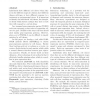Free Online Productivity Tools
i2Speak
i2Symbol
i2OCR
iTex2Img
iWeb2Print
iWeb2Shot
i2Type
iPdf2Split
iPdf2Merge
i2Bopomofo
i2Arabic
i2Style
i2Image
i2PDF
iLatex2Rtf
Sci2ools
SDM
2007
SIAM
2007
SIAM
Lattice based Clustering of Temporal Gene-Expression Matrices
Individuals show different cell classes when they are in the different stages of a disease, have different disease subtypes, or have different response to a treatment or environmental stress. It is important to identify the individuals’ cell classes, for example, to decide which disease subtype they have or how they will respond to a certain drug. In a temporal gene-expression matrix (TGEM) each row represents a time series of expression values of a gene. TGEMs of the same cell class should show similar gene-expression patterns. However, given a set of TGEMs, it can be difficult to classify matrices by cell classes. In this paper, we develop a tool called LABSTER (LAttice Based cluSTERing) to cluster gene-expression matrices by cell classes. Rather than treating each row or column as a vector, we create a Galois lattice for each matrix, which yields a natural distance function between gene expression matrices. Finally, we cluster based on these distances. A key advantage of our ...
| Added | 30 Oct 2010 |
| Updated | 30 Oct 2010 |
| Type | Conference |
| Year | 2007 |
| Where | SDM |
| Authors | Yang Huang, Martin Farach-Colton |
Comments (0)

